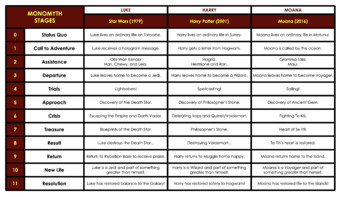Monomyth Cycle (Hero's Journey) Activity Using "Piper" (2016) – Pixar Short Film
- Google Drive™ folder

What educators are saying
Description
Piper (2016) is a Pixar short film that follows the journey of a young, sandpiper (bird) aptly named, Piper! This activity uses the short film as a way to engage student discussion and analysis of the Monomyth Cycle, or Hero's Journey.
As of February 11, 2022, the short film is available on the Disney+ streaming service, or alternatively, you can purchase the Pixar Short Films Collection: Volume 3 on Amazon, which includes Piper.
It is highly recommend this short film is paired with the publicly available video created by TED-Ed and Matthew Winkler entitled, "What Makes a Hero?"
The primary goals of this activity are to (1) introduce students to the concept of the Monomyth Cycle, or the Hero's Journey, and (2) get students to analyze a short film using the common steps in the Monomyth Cycle, or Hero's Journey.
What's Included for the Monomyth (Hero's Journey) Activity?
- Information Sheet with Examples and Fillable Tables
- A Blank Analysis Page for Piper Analysis
- The Answer Key to the Piper Analysis with Stills
- Slides to Guide the Activity and Discussion
- The Information Sheet – includes an overview of the activity with steps; an explanation of the Monomyth Cycle (Hero's Journey); examples of using popular stories, like Star Wars, Harry Potter, and Moana; and a blank "Make Your Own" analysis table. There is a Google Doc and PDF version included.
- The Blank Analysis Page – includes a blank, fillable table to analyze the short film, Piper. There is a Google Doc and PDF version included.
- The Answer Key – includes text answers to the Blank Analysis Page for Piper. It also includes stills from the short film and time-codes to provide further explanation. There is a Google Doc and PDF version included.
- The Slides – includes an opening graphic, an embedded YouTube video of Matthew Winkler's TED-Ed Talk, a visual of the examples from popular films, a transition slide for watching the Piper short film, the blank analysis page for Piper, a slide-by-slide breakdown of the analysis answers, and a visual for the "Make Your Own" table. There is a Google Slides and PDF version included.
A Description of Activity to Share with Students
What is a Monomyth, or Hero's Journey? This activity is not a definitive guide to all monomyths – it depends on who you ask! If you want to know how many stages there are in the Monomyth. There is a general consensus that the monomyth has three acts – departure, initiation, and return. Popularized by Joseph Campbell, Campbell lists 17 stages, while others have augmented the list to varying stages (e.g., David Adams Leeming in 1981 suggested 8 stages, Phil Cousineau in 1990 suggested 8 stages, and in 2007, Christopher Vogler proposed 12 stages). In fact, the stages in this activity are remixed from the Ted-Ed video by Matthew Winkler. You can actually get really deep into the specific aspects of the structure, including friendships, glowing/ghost-like mentors, temptations, magic flight, long lost family reveal, etc. Again, the main goal is to get an understanding that many stories are remixes and have frameworks of older stories!
If you have any questions or feedback, please reach out via TPT, or e-mail me at erikkteaches@gmail.com





